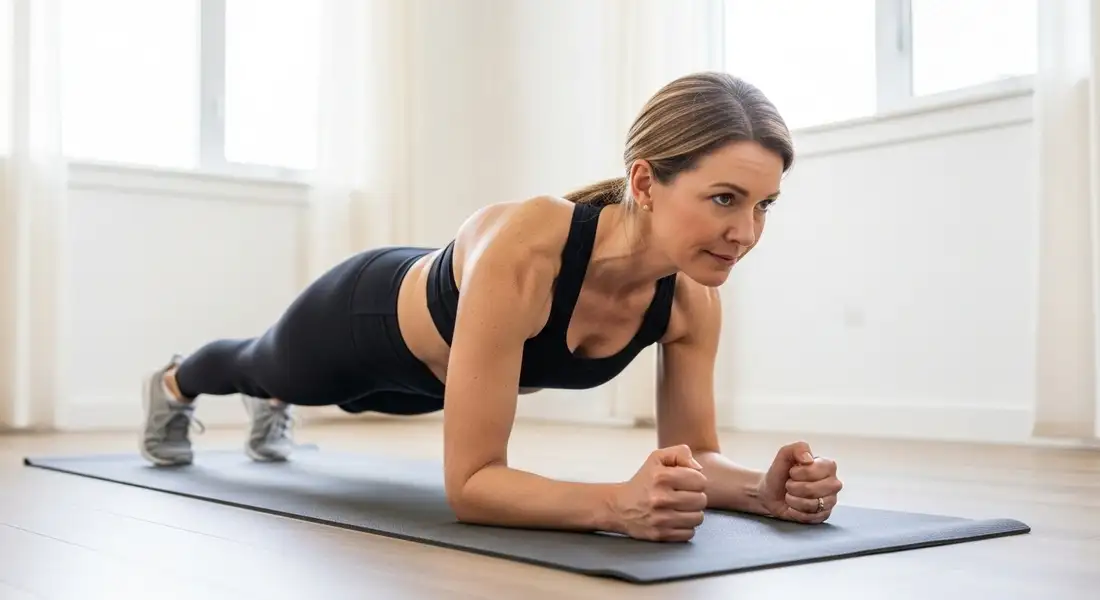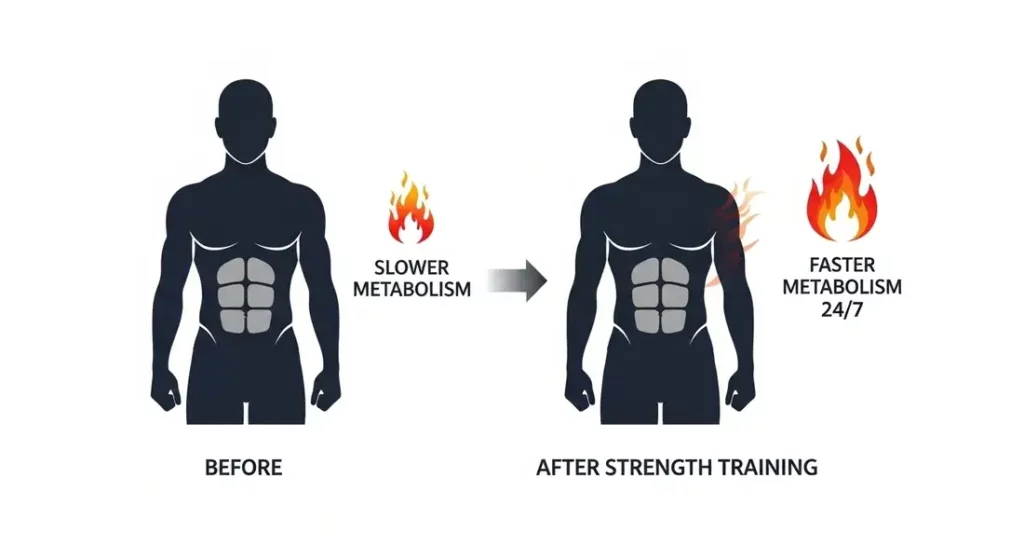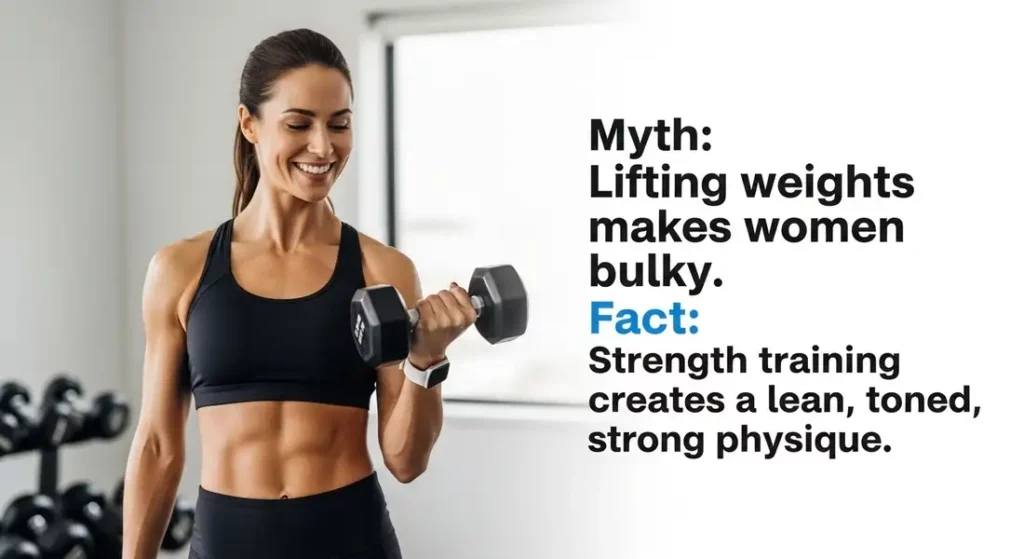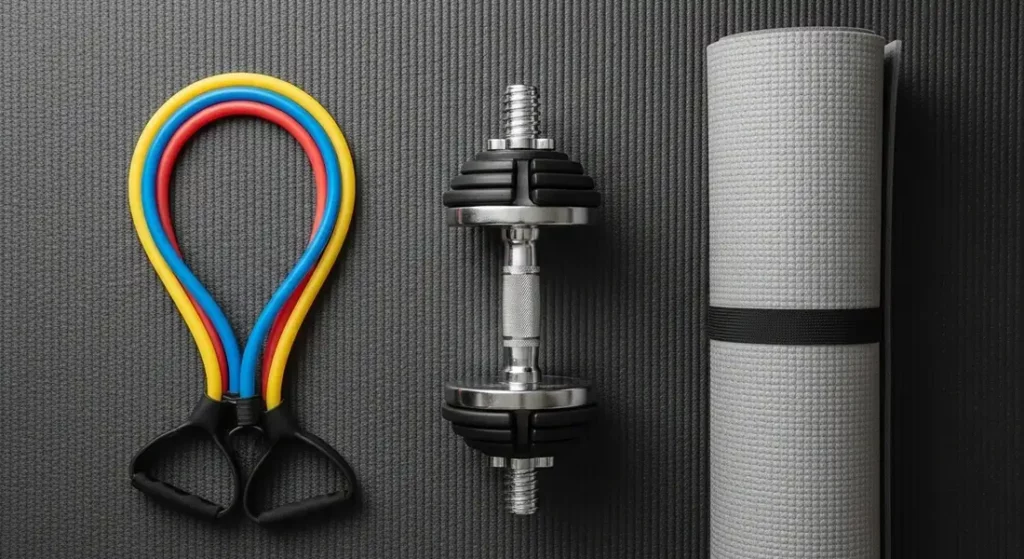In the world of weight loss, cardio often steals the spotlight.
But what if I told you that the secret to a more efficient, sustainable, and sculpted physique lies in what you do after the cardio session?

Welcome to the power of strength training.
This guide, a core part of our Beginner’s Guide to Weight Loss at Home series, is your starting coach for building muscle.
We’ll demolish the myths that hold beginners back and show you why strength training is the most powerful tool in your weight loss arsenal for building a lean, fat-burning body right from your living room.
Why Strength Training is a Weight Loss Game-Changer
While cardio burns calories during the workout, strength training transforms your body into a more efficient calorie-burning machine 24/7.

It does this by increasing your muscle mass, which in turn boosts your Basal Metabolic Rate (BMR)—the number of calories your body burns just to exist.
More importantly, it improves your body composition, helping you lose fat while building lean, sculpted muscle.
Getting Started – Your First Steps at Home
You don’t need a rack of heavy weights to begin.
The most effective tool you own is your own body.
Mastering fundamental bodyweight movements like squats, push-ups (on knees is a great start!), planks, and lunges will build a rock-solid foundation.
Bodyweight Basics – Your Foundation of Strength
Mastering these five fundamental movements will build a rock-solid foundation for any future training.
Focus on perfect form before you even think about adding weight.
| Exercise | How to Perform | Key Focus |
| Squats | Stand with feet shoulder-width apart. Lower your hips back and down as if sitting in a chair, keeping your chest up. | Drive through your heels; keep knees behind toes. |
| Push-ups | From a plank position, lower your body until your chest nearly touches the floor. Push back up. (Can be done on knees). | Keep your core tight and back flat. |
| Plank | Hold a push-up position, resting on your forearms. Keep a straight line from your head to your heels. | Don’t let your hips sag. |
| Lunges | Step forward with one leg and lower your hips until both knees are bent at a 90-degree angle. Push back to the start. | Keep your front knee aligned with your ankle. |
| Glute Bridges | Lie on your back with knees bent. Lift your hips off the floor until your body forms a straight line from shoulders to knees. | Squeeze your glutes at the top. |
Essential Beginner Equipment
Once you’re comfortable with bodyweight exercises, a small investment in simple equipment can unlock hundreds of new exercises.
- Dumbbells: Start with a light set (5-10 lbs). They are versatile and perfect for adding resistance to exercises like lunges, squats, and overhead presses.
- Resistance Bands: These are inexpensive, space-saving, and fantastic for targeting smaller stabilizer muscles. They provide tension throughout the entire movement.
Related Reading: Sandbag Training Vs. Traditional Weightlifting – Uncovering The Key Differences
Overcoming the Biggest Beginner Hurdles
Starting something new can be intimidating. As a coach, I hear the same legitimate concerns from beginners all the time.
Let’s tackle them head-on.

Problem: “I’m a woman, and I’m afraid of getting ‘bulky’.”
This is the number one myth that holds women back from the incredible benefits of strength training.
The truth is, it is biologically very difficult for women to build large, bulky muscles.
Women have significantly lower levels of testosterone, the primary hormone responsible for muscle hypertrophy (growth).
The lean, strong, and “toned” physique many women desire is the direct result of building a solid foundation of muscle through strength training.
Problem: “I’m scared of getting injured because I don’t know if my form is correct.”
This is a smart and valid concern. The solution is to prioritize learning over lifting.
- Start with Bodyweight Only: Master the movements using just your body. There is zero risk of injury from a properly performed bodyweight squat.
- Use Your Phone: Record yourself doing an exercise from the side. Compare it to a video of a certified trainer demonstrating the same move. You’ll be amazed at what you can learn.
- Go Slow: Perform each repetition in a slow, controlled manner. This builds a stronger mind-muscle connection and is safer than using momentum.
Coach’s Toolkit – Your Home Strength-Building Kit
Once you’re confident with bodyweight basics, a few key accessories can unlock hundreds of new exercises and help you progress safely.

- A High-Quality Yoga Mat: Don’t do floor exercises on the hard ground or a slippery towel. A good mat provides crucial cushioning for your spine, knees, and wrists during exercises like planks, push-ups, and core work. It also creates a dedicated, non-slip space for your workout.
- Resistance Loop Bands: These are the most versatile and budget-friendly strength tool you can own. These small loops are perfect for activating your glutes before a workout and for adding a significant challenge to exercises like squats, hip thrusts, and lateral walks without needing a single weight.
- Adjustable Dumbbells: When you are ready to invest in your strength, a set of adjustable dumbbells is the single smartest purchase for a home gym. They replace an entire rack of traditional dumbbells, saving an enormous amount of space and money. With the simple turn of a dial, you can progress from 5 lbs all the way up to 50 lbs or more.
Common Mistakes Beginners Must Avoid
Avoiding these common pitfalls will keep you safe and ensure you make steady progress.
- Too Much, Too Soon: Your enthusiasm is great, but trying to lift too heavy or work out every day leads to burnout and injury.
- Ignoring Form: This is the most critical point. Bad form is a direct path to injury.
- Skipping the Warm-up & Cool-down: A 5-10 minute warm-up is non-negotiable. A cool-down with stretching aids recovery.
- Neglecting Rest Days: Muscle is built during recovery, not in the gym. Rest days are when the magic happens.
The Coach’s Corner – Understanding Progressive Overload
How do you keep getting results after the first few weeks?
The secret is a principle called Progressive Overload.
It simply means you must continually find ways to make your workouts slightly more challenging over time.
If you do the same thing forever, your body will adapt and stop changing.
For a beginner, this can be as simple as:
- Adding 2 more reps to your set.
- Adding one more set to your workout.
- Slowing down the movement to increase time under tension.
- Decreasing your rest time between sets by 15 seconds.
Don’t overthink it.
Just aim to do a tiny bit more than you did last week. That’s the secret to long-term progress.
Return to the Beginner’s Guide to Weight Loss at Home to see how strength training fits into a complete weekly plan.
What’s your biggest question or concern about starting with strength training? Ask away in the comments—let’s tackle it together!
